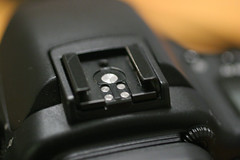Camera basics - flash
The purpose of a flash is to add light to a subject when the situation is too dark. Also, flash can be used to add additional light to "fill" out the picture, softening shadows and bringing out a subject.
Flashes have an effective distance. Beyond that, the flash is useless. It's be like trying to light up the Golden Gate Bridge with a desk lamp. So please turn off your flash when you're shooting at a distance.
Most cameras these days have built-in flashes. For the most part, these flashes are underpowered, and will actually detract from the quality of your photos. Whenever possible, it's always better to use an external flash. External flashes have more control, and also can be aimed and diffused, or remotely activated! This versatility lends itself to flash bounce. I'll talk about that in photo techniques.
External flashes attach via a "hotshoe" which signals the shutter release to the external flash. Be careful about using external flashes with new cameras. Sometimes the voltages don't match, and you can damage your camera. Your best (but most expensive) bet is finding a flash that was designed to work with your camera.
Most flashes will require some cycle time to recharge, so pictures taken in rapid succession may not flash!








No comments:
Post a Comment